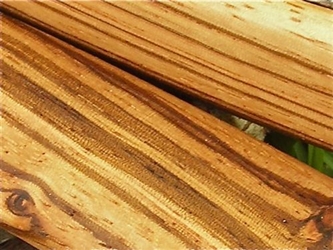 |
Zebrawood
Zebrawood is a hard and heavy exotic wood from West Africa that delivers a medium low tone.
This strong, stiff and fairly dense wood is distinctive for its zebra-like light and dark stripes. The relatively few woodworkers who know about Zebrawood are awed by its dramatic pattern. Zebrawood is moderately expensive, and because its use is so limited, it is only available in small quantities.
Bone Rattling Facts
The material is well suited for hand-held musical instruments because it is durable, dimensionally stable, retains its shape after manufacture and is resistant to insects. It is sometimes seen in exotic guitars. "As a tonewood...the Zebrawood I have handled is very similar to Indian Rosewood in terms of taptone and physical properties," reports Terence Tan of Guitarbench.com.
Cool Facts
-
The tree is a member of the legume family (peas and beans) and produces pods
-
If you are old enough, you might remember seeing Zebrawood on car dashboards. Wiki reports the wood was used in Cadillac and Mercedes-Benz automobiles.
Figures below are approximate (but pretty darn close)
Tonality
Can't Decide Which Bones to Choose?
Check out this handy guide: Bone FAQs
Scroll down for technical Zebrawood facts...
|
|
Zebrawood Facts
Scientific Name
Microberlinia brazzavillensis (aka: Microberlinia bisulcata)
Zebrawood is classified under the genus Microberlinia in the family Fabaceae (Leguminosae).
Other Names
African zebrawood
Allen ele
Amouk
Izingana
Zebrano
Zingana
Lookalike Woods
Goncalo Alves.
Marblewood (marmoxylon racemosum - Surinam, Brazil)
Muiracataria (astronium leicointei)
Grain
The grain is usually wavy or interlocked and might suggest the look of a ribbon.
Texture
This wood has texture that is typically medium to coarse.
Luster
Zebrawood is described as lustrous.
Heartwood Color
Tan and dark brown
(Caramel Fudge Swirl)
The heartwood is a light golden-yellow or pale yellow-brown with dark blackish brown streaks that vaguely resemble zebra stripes.
Sapwood Color
The sapwood is pale white.
Aroma
Zebrawood emits an unpleasant smell when green or being worked. The odor disappears when the wood is dry.
Toxicity
Severe reactions are quite uncommon. Zebrawood has been reported as a sensitizer. The most common reactions are usually eye and skin irritation.
Woodworking
This wood is easy to saw but difficult to plane or sand because of its interlocking grain. The surface polishes well but experts recommend a belt sander to get a good smooth finish.
Environmental Profile
Some material from this species is reported to be available from sustainably managed or other environmentally responsible sources.
The International Tropical Timber Organization (ITTO) reports that timber from Zebrawood is produced in regular but limited quantities and exported regularly.
Distribution
The species is distributed in West Africa, especially in Cameroon, Congo and Gabon. It is sometimes found in pure stands along river banks. can be difficult to harvest because trees can grow very large and are often located in inaccessible areas.
Tree Data
The tree grows from 150 to 200 feet (45-60 m) tall with a diameter from 48 to 60 inches (120 to 150 cm).
The trees usually have a very thick bark which is removed at harvesting sites.
|
|
|